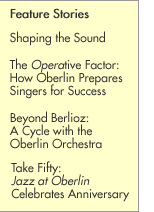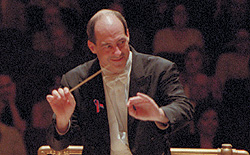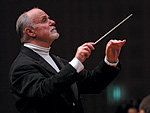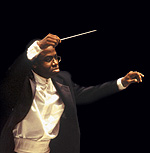
 |
|
Home :: Features :: Shaping the Sound Shaping the Sound
Of all the people assembled onstage during an orchestral concert, surely it is the most prominent one—the one on the podium—whose job is the least understood by most of the audience. In 1967, the late Harold Schonberg, who spent two decades as senior music critic of the New York Times, published a book titled The Great Conductors in which he chronicled that particular species of performer. Right at the beginning he laid down the requirements for the ideal aspirant to the profession: “He is of commanding presence, infinite dignity, fabulous memory, vast experience, high temperament, and serene wisdom. He has been tempered in the crucible but he is still molten and he glows with a fierce inner light. He is many things: musician, administrator, executive, minister, psychologist, technician, philosopher, and dispenser of wrath. Above all, he is a leader of men.” To which one might add that an impressive number of conductors today—and not just “he’s,” by the way—are graduates of the Oberlin Conservatory of Music. Conducting majors represent a minuscule percentage of the Conservatory’s graduates, yet a surprising number of Obies have gone on to stake notable positions in the national and international orchestral conducting scene. Some are household names to most music lovers; others enjoy more regional celebrity. Some make the rounds of the world’s most sought-after podiums; others have embraced the specific challenges of their communities and persevered against difficult odds to keep their audiences supplied with the best music possible. “A conductor’s work is never done, because you’re supposed to know everything and hear everything,” says Robert Spano ’83, music director of the Atlanta Symphony who recently relinquished the similar post he had held since 1996 at the Brooklyn Philharmonic. Learning to Conduct
“A conductor’s task is to define the way a particular score is to be realized,” says Spano, “and the skill of conducting, therefore, has to do with the efficacy of one’s communication to the orchestra to achieve that interpretation. A conductor has to make sure he has a vision and then figure out how to steer an orchestra toward supporting that vision. There’s a certain amount of guesswork involved in that process. The conductor Max Rudolf, who was greatly respected as a teacher of conducting, said: ‘It’s all guessing, but there’s wild guessing and there’s educated guessing.’ Conductors develop particular skills to minimize the ‘wild guessing.’” Although he did study conducting at Oberlin, Spano was actually a piano major. In fact, quite a few Oberlin-educated conductors majored in something other than conducting, achieving advanced expertise in instrumental performance before proceeding toward a profession on the podium. One such is David Zinman ’58, the most eminent conductor to issue out of Oberlin. Music director of the Zurich Tonhalle Orchestra and the Aspen Music Festival and School, Zinman is also artistic director for the American Academy of Conducting. He majored in violin at Oberlin, even though he allows that he truly always wanted to be a conductor.
“I studied conducting with David Robertson,” he recalls. “It was a very rudimentary course that met maybe once a week, and we learned the basic beat patterns for conducting in meters of four, of three, of two—that sort of thing. But I was lucky because Dr. Robertson gave me a chance to really conduct, and I did conduct, a lot. I conducted student productions of musical comedies, I don’t know how many performances of L’histoire du soldat, even some operas. I also was the librarian for the orchestra, so I had the keys to the scores and parts. Every Saturday we convened a ‘reading orchestra,’ and anybody who wanted to read repertoire would show up. I would often conduct. “I think the reason so many conductors have emerged from Oberlin is that the school has always encouraged people to get involved in extracurricular music-making—the Gilbert & Sullivan Players, the Mummers, opera workshops. I even worked with the Elyria Little Symphony, which was an amateur orchestra. Young conductors must understand that they need to take every opportunity and make something of it.” Obviously, one does not move immediately from leading the Elyria Little Symphony to directing the Zurich Tonhalle Orchestra. In Zinman’s case, the interim steps included a master’s degree in composition from the University of Minnesota; extensive study with the legendary conductor Pierre Monteux, both at Tanglewood and at his center for conducting in Maine; guest conducting all over Europe and the United States; and, eventually, holding the music directorships of the Netherlands Chamber Orchestra, the Rotterdam Philharmonic, the Rochester Philharmonic, and the Baltimore Symphony, where he served from 1985 to 1998. “Conducting is not a career you can really plan,” Zinman says. “Opportunities fell into my lap, and I was able to make them work. If early on I had failed, who knows?” Where Oberlin Fits In “Oberlin’s record in producing conductors has partly to do with the quality of the minds that come here to begin with, but also with the breadth of the Conservatory’s curriculum and the specific training we provide to people who show an interest in conducting,” says Dodson. “Except in rare cases, you don’t become a conductor at Oberlin; you become the germ of a conductor. Realistically, our goal is not to produce graduates who can step into music directorships of major orchestras. But we can awaken students to discovering their own inner attributes and desires that could lead toward such a career. “Extensive training in conducting typically takes place on the graduate level and in specialized programs like those at Tanglewood or Aspen,” Dodson continues. “But a student has to reach a point where he or she can be admitted to Tanglewood or Aspen, and that’s where Oberlin fits in. Celebrity is not at the heart of the student ethic here, but musicianship is. We’re very good at helping students develop their musicianship and expanding their inquisitiveness—and in some cases that leads to our students developing into conductors.” The Conservatory also brings noted conductors to campus, most recently Sir Simon Rattle and Franz Welser-Möst, to rehearse the student orchestras. These rehearsals are valuable for orchestral players, but for conducting students they are 24-carat experiences. That conductors should get a late start toward their profession is not surprising. By the time most students get a chance to practice conducting in any sustained way, it’s likely that they will have already become relatively seasoned performers on some instrument. But for those who demonstrate unusual talent for conducting, the Conservatory offers a fifth-year master’s degree program; along with master’s curricula in opera theater, historical performance, and music education, it stands as something of an anomaly in the offerings of an institution that otherwise concentrates on undergraduate education. The Baustian Legacy “We put up a strong argument for it,” he recalls. “If a student was really interested in conducting, we’d get them going with some concentrated conducting courses in their senior year. Then we added a further year to keep at it, to help give them a start toward a career. I put them on the podium as much as I could. I’d give them rehearsal time with the orchestra and then afterward I’d present them with a laundry list of notes I’d made while watching them. “We also made sure they had the basic skills they would need as conductors, like score reading, playing scores at the piano, and ear training. You know, when young, aspiring conductors would visit George Szell in Cleveland, hoping for a job of some sort, he’d walk to the piano and smash down 10 fingers’ worth of notes. Then he’d say, ‘Spell!’ And if they couldn’t spell the chord correctly, he’d say, ‘Come back when you can.’ The best conductors listen with their ‘inner ear’ to all the lines, vertical and horizontal, until they have an aural picture of what the music will be.” A certain generation of Oberlin conductors remembers Baustian as a tough but involved mentor. One of his pupils was Spano, who was admitted to the master’s program but was diverted into a busy career before he finished it.
Another Baustian protégé was Michael Morgan ’79, since 1990 the music director of the Oakland East Bay Symphony. He won first prize in the Hans Swarowsky International Conducting Competition in Vienna the year after he graduated and then went on to an assistant conductorship at the Chicago Symphony. In what he calls a “14-year honeymoon” in Oakland, Morgan not only has instituted musical standards of a very high order, but he also has turned around an organization that was on the brink of folding when he inherited it—mirroring the similar miracles he wrought with the once-teetering Sacramento Philharmonic and the Festival Opera of Walnut Creek (California), both of which he also directs. Intense and focused in his expression, Morgan is obviously a fellow who meets challenges head-on. “It takes a lot of energy,” he says. “It’s what needs doing. You get organizations to readjust. A conductor has to spend a lot of time working in the community. That’s the only way an orchestra can survive. I learned how to do it at the Chicago Symphony by addressing that orchestra’s standing and reputation in communities that weren’t attached to it historically, such as the African American and Hispanic communities. From that I learned the importance of connecting an orchestra to its community, and what works and what doesn’t work in doing that.” |



